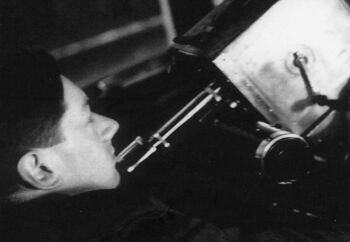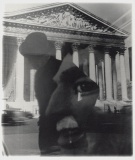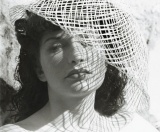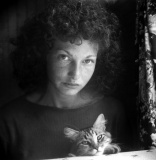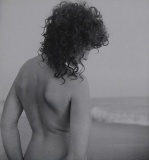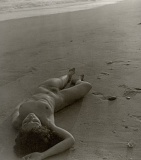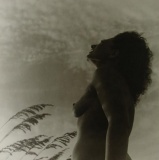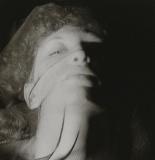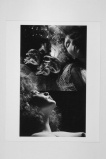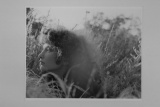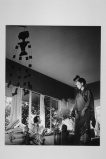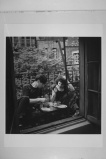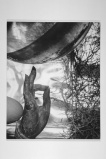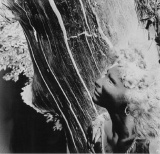Alexandr Hackenschmied
 Photo by Maya Deren, c1942-43. | |
| Born |
December 17, 1907 Linz, Austria-Hungary |
|---|---|
| Died |
July 26, 2004 (aged 96) New York City, United States |
| Web | UbuWeb, Wikipedia |
Alexandr Hackenschmied (1907–2004) was a leading photographer and filmmaker in Czechoslovakia between the two world wars. He immigrated to the U.S. in 1939 and became involved in American avant-garde cinema. The film Meshes of the Afternoon he made with then-wife Maya Deren has become an icon of avant-garde cinema. He changed his name to Alexander Hammid when he became a citizen of the United States in 1946. He is best known for his work in documentary film, both as a director, cameraman, and editor.
Life and work[edit]
Born Alexander Siegfried Georg Smahel in 1907 in Linz, at that time part of the Austro-Hungarian Empire to Bozena Smahelova, a piano teacher and Frantisek X Hackenschmied, a high school teacher. From early childhood he grew up in the Prague's industrial district Karlín.[1]
- Studies and contacts with photography
From 1919 he attended high school in Libeň district of Prague, then continued in the Karlín district. At the time he had already been interested in the fine arts, and began to take photographs when his uncle had given him a Voigtländer 6 x 9 cm camera. In 1922 he bought a 9 x 12 cm camera and set up a dark room. At the same time he also developed an interest in motion pictures and with his schoolmate Ladislav Berka closely followed the work of leading filmmakers.[2]
In 1927 he began study of architecture at the Czech Institute of Technology (ČVUT), but soon switched to art history at Charles University, Prague.[3][4]
- Film criticism and photography
In 1929, Hackenschmied visited with Berka the I. international exhibition Film und Fotografie in Stuttgart, and published an article about it in Fotografický obzor [Photographic Horizon]. He became a founding member of the Film-klub, and began to write about film for the illustrated weekly Pestrý týden (edited by Jaromír John-Markalous) and Národní osvobození.[5] In 1930 he published his manifesto articles "Nezávislý film--světové hnutí" [Independent Film--A World Movement] and "Avantgarda žije" [The Avant-Garde is Alive].[6]
Inspired by the Stuttgart exhibition and encouraged by the publisher Otakar Štorch-Marien, in 1930 he organised a similar exhibition in the newly opened exhibition hall at Štorch's Aventinská mansarda at Purkyně street in Prague. Nová fotografie [New Photography] showcased the new tendencies in Czech photography of the time (Jaromír Funke, Josef Sudek, Eugen Wiškovský, Josef Ehm, Ladislav Berka, Jiří Lehovec, Hackenschmied himself, and others).[7] Following year, he organised its second edition.
Hackenschmied however understood writing and photography as an intermediate step towards fully focusing on film, eventually quitting both in Spring 1931 for the time being.[8][9]
- Experimental film work
Hackenschmied got to work in film studios through his background in architecture. Already in 1929 he was helping, together with his friend from studies Ladislav Machoň, the German architect Eduard Borsody during the shooting of Gustav Machatý's film Erotikon. Later he worked as artistic adviser for another Machatý's film, Ze soboty na neděli [From Saturday to Sunday] (1931), and together with the film architect Hanuš Gödert on film adaptation of František Langer's comedy Obrácení Ferdyše Pištory (1931), directed by Josef Kodíček (also Hackenschmied's first editing work on a sound film). Despite either of the films were not particularly mainstream, Hackenschmied stopped being interested in feature film production and moved his attention to "independent film".[10]
In 1930, he borrowed an amateur hand camera Kinamo from his journalist colleague Otto Rádel, cheaply bought the leftovers of the unexposed negative rolls from the cinematographers Blažek, Stallich and Vích of Vinohrady's A-B studios, and detoured Prague and its suburbs to create his first, silent, film Bezúčelná procházka [Aimless Walk], which eventually inaugurated the movement of avant-garde film in Czechoslovakia. The film had its premiere in November 1930 at the well received Týden avantgardních filmů [Avant-Garde Film Week] he organised, together with Ladislav Kolda, at Prague's Kotva cinema, next to films by René Clair (Entre 'acte), Jean Vigo (À propos de Nice), Jean Painlevé, Eli Lotar, Man Ray, or Henri Chomette.[11] Two further weeks were organised in 1931 and a further programme of Czech avant-garde films in May 1937.[1]
In 1932 he bought a handheld camera Bell-Howell and made his second film, Na Pražském hradě [Prague Castle], in close collaboration with the composer of the sound track, striving for an organic intertwining of image and music. On the same principle, he edited the film Zem spieva [The Earth Sings], which was photographed by Karol Plicka and produced by Ladislav Kolda; the film received award at the Venice Film Festival.[12][13] In 1934 he collaborated as a cameraman on Otakar Vávra's Listopad [November].[14]
- Zlín
From 1935, Hackenschmied worked for the Baťa Film Studio in Zlín, founded by Jan Antonín Baťa in the 1930s who hired young filmmakers and artists to develop modern films, primarily for advertising. While employed there, Hackenschmied made numerous advertising and documentary films. In 1935 he attended the first Soviet film festival in Moscow; in 1936 traveled to the United States (New York, Chicago, and Los Angeles) with colleagues from Zlín, Ladislav Kolda, František Pilát, and Elmar Klos, to purchase film equipment for a new studio in Zlín, making a series of photographs during the trip. One of the most famous films he worked on during this period is the film advertisement entitled Silnice zpívá [The Highway Sings] (1937), directed by Elmar Klos, and showing auto tires in motion. It won the Gold Medal at the Paris Exhibition. The same year he accompanied Jan Baťa on his trip to India and Ceylon, traveling alone, he took photographs and shot informal footage that was later edited by others at the Bata studios into three short documentaries: Chudí lidé [Poor People], Řeka života [River of Life and Death] a Vzpomínka na ráj [Memories of Paradise].[15][16]
- Emigration to the US
In Spring 1938, he began to work as a cinematographer for the leftist American documentarian Herbert Kline on the feature-length documentary Crisis about the political situation in the Sudetenland region of Czechoslovakia. During filming, political events in Czechoslovakia had turned into an international conflict; at the end of the year Kline had to smuggle the footage out of the country to Paris, where he was joined by Hackenschmied in February (and who stayed there until June). Crisis premiered in New York on 13 March, two days before the German occupation of Bohemia and Moravia. With Kline, he filmed Lights Out in Europe, about the pre-war atmosphere in England. At Christmas, he left London for New York. In 1940 he worked in Mexico with Kline on The Forgotten Village, a film based on a screenplay by John Steinbeck; editing the film in early 1941 in Los Angeles. Later that year he worked briefly as a technical adviser for the Paramount studio.[17][18][19]
- Collaboration with Maya Deren
In May 1942 he met Eleonora Deren (later Maya, the name given to her by Hackenschmied, which she adopted as her own), an intellectual of Ukrainian origin who was ten years younger and traveling as an assistant with the Katherine Dunham dance company. They soon began to live together and were married three months later. Eleonora, who until that time had been interested mainly in modern dance and poetry, learned about photography from him and was also introduced to filmmaking. She was the model for many photographic studies by Hackenschmied. The two became close friends with Galka Scheyer, a German collector and promoter of modern art.[20][21][22]
In January 1943, Hackenschmied had a one-man photography exhibition in the Pasadena Institute of Art, which in March opened in the American Contemporary Gallery, Hollywood. Using their home in the canyons above Los Angeles in California, they made the film Meshes of the Afternoon, which came to be seen as a groundbreaking work which charted a new course for American avant-garde cinema. In this respect it holds a position in the history of American film similar to that of Bezúčelná procházka in Czech cinema. The parallels between these films, however, run deeper--both contain the motif of the mirroring and splitting of the main character and both represent a shift to a subjective vision, evoking the inner world of the dream or imagination.[23][24][25]
In May 1943, they moved to New York, settling in Greenwich Village. He began to work as a director and maker of documentary films for the Office of War Information (OWI), for which he made the Valley of Tennessee (1945), and three other films, including The Hymn of the Nations (1944) with Arturo Toscanini conducting, and Library of Congress (1945) which was nominated for an Academy Award for Best Short Documentary.[26][27]
In 1944 he took part in the filming and editing of Deren's own first film, At Land. Her cameraman on this film, as well as on the other two by Deren, was the photographer of German origin, Hella Heyman, whom Hackenschmied had initiated into work with the motion-picture camera.[28]
Hackenschmied also made the 22-minute short The Private Life of a Cat (1945) shot entirely in his and Deren's Morton Street apartment in Manhattan. This short film was part narrative, part documentary about cats and their daily lives. The film starts off with two cats, a male and a female. The female is eventually impregnated by the male cat, and begins to search for shelter for when she gives birth to her kittens. The film shows her giving birth to five kittens in graphic detail. The same year he worked with Deren on the film A Study in Choreography for Camera, and later helped her to make her third independent film Ritual in Transfigured Time (1946).[29][30]
After being granted American citizenship in 1946 he shortened his name to Hammid.[31]
Deren summarized the character of his work as follows: "Because Sasha is a wonderful combination of formalist and humanist tendencies, it gives his work a terrible lyricism. He is incapable of sentimentality because of a terrific sense of form; and he is incapable of formalism because of a profoundly child-like love of things and tenderness." (from The Legend of Maya Deren: Chamber (1942-1947), p 35)
Hammid and Deren divorced in 1947. Shortly later she won the Grand Prix Internationale in the avant-garde film category at the Cannes International Film Festival.
- Multi-screen and IMAX films
Hammid married Hella Heyman the next year. They moved to the upper west side of Manhattan, where they raised two children, Julia (1950) and Tino (1952).[32]
Hammid began to work as a director and editor for the film department of The United Nations in 1952, where he remained for two years. Head of Production was Thorold Dickinson.[33]
From 1962, Hammid worked in partnership with his friend the filmmaker and painter Francis Thompson (1908–2003) for over 25 years, producing numerous “in-house” documentaries as well as several films for general viewership. They made a number of large-scale multi-screen films including To Be Alive! (for screening at the 1964 New York World's Fair; the film won an Oscar for best short documentary in 1966), We Are Young (a film about Canada, for Expo 67 Montreal where it was projected on six screens) and US (for San Antonio's HemisFair World's Fair 1969). Another notable is the first IMAX format film, To Fly! (1976), which premiered at the Smithsonian Institution’s National Air and Space Museum (NASM) at the museum’s grand opening celebration on 1 July 1976; produced in conjunction with MacGillivray Freeman Films, it continues to play regularly at the Air and Space Museum. Graham Ferguson, owner of the IMAX Corp. (speaking at Francis Thompson’s memorial service in 2004) recalled how he had wanted Hammid and Thompson to make the first commercial IMAX films because of their extensive work in earlier large-scale multi-screen films. Hammid continued to work as a film editor on multi-screen and IMAX films until 1986.[34][35]
- Later recognition of his work
The American historian Thomas A. Valasek published an extensive article on Hackenschmied in the prestigious journal Film Culture in 1979, and was the first to acknowledge fully Hackenschmied's important role in Meshes of the Afternoon and his contribution to other films by Maya Deren.[36]
In 1981, The Moravian Gallery in Brno organised an exhibition, Czech Photography, 1918-38, which re-discovered Hackenschmied's fundamental contribution to Czech avant-garde photography (curated by Antonín Dufek and Jaroslav Anděl).[37]
The Anthology Film Archives, New York, presented the first retrospective of his films (the curator was Catrina Neiman) in 1989. His photography from the period between the two world wars was first presented in larger quantity at the Aventinské trio (Hackenschmied, Berka, Lehovec) exhibition (1989), which was organised by the Moravian Gallery in Brno (curated by Antonín Dufek). His photographs and films were part of the first show of Czech modern art in the USA, organised by the Museum of Fine Arts, Houston (1989). Martina Kudláček made a 48-minute film about Hackenschmied called Bezúčelná procházka - Alexandr Hammid in 1996. The Moravian Gallery in Brno organised a one-man exhibition of his work in 1997 (curated by Antonín Dufek). The South-East Moravian Museum in Zlín held an exhibition of his photographs in 1999. The same year The Goethe Institute in Bratislava presented an exhibition of his work together with the work of Hella and their son Tino.[38] In 2000, Jaroslav Anděl wrote a 140-page bilingual book on life and work of Hackenschmied[39], reproducing dozens of his photographs. This now out-of-print book, together with a 1973 book by Jaroslav Brož[40], served as the main source for this article.
- Late years
In 1986, on the occasion of the recording of the music for the IMAX film On the Wing, Hammid visited his native country for the first time in almost fifty years.[41]
Both Hammid and Thompson retired in 1986, and their company, Francis Thompson Inc., closed down.
Hammid died at his home in New York City in 2004.
Photography[edit]
Film[edit]
Bezúčelná procházka (Aimless Walk)[edit]
Dir., camera and editing: Alexandr Hackenschmied, 35 mm, 8 min, 219 m, b&w, 1930. Download (WEBM), View at UbuWeb, IMDB
Produced by Ladislav Kolda.
First true Czech avant-garde film turns away from a purely celebratory approach to the city. The camera follows a detached protagonist on his wanderings, as his highly subjective journey becomes a fragmented visualization of urban landscapes.
Na Pražském hradě (Prague Castle)[edit]
Dir. Alexandr Hackenschmied, 11 min, 324 m, 1932. Download (WEBM), View at UbuWeb, IMDB
Produced by Ladislav Kolda.
Film sketch of the Prague Castle and its most outstanding landmark - the St Vitus Cathedral. The effect of the pictorial form of the film is enhanced by the music of Frantisek Bartos.
Meshes of the Afternoon[edit]
Dir. Alexandr Hackenschmied and Maya Deren, 13 min, 1943. Download (WEBM)
The Private Life of a Cat[edit]
Dir. Alexandr Hackenschmied, 22 min, 1945. Download (WEBM)
Filmography[edit]
- Avant-garde films
- Bezúčelná procházka [Aimless Walk], 1930.
- Na Pražském hradě [Prague Castle], 1932.
- with Maya Deren, Meshes of the Afternoon, 1943. (also cameraman and editor)
- The Private Life of a Cat, 1945.
- Documentary films
- Město živé vody, 1934.
- with Herbert Kline and Hans Burger, Crisis, 84 min, 1938-39. (also cameraman) [2]
- with Herbert Kline, Lights Out in Europe, 68 min, 1939-40. (also cameraman and editor) [3]
- with Herbert Kline, The Forgotten Village, 1940. (also cameraman and editor)
- Advertising films
- Karlovy vary [Karlsbad], 1934.
- Mariánské Lázně [Marienbad], 1934.
- Jáchymov [Joachimsthal], 1934.
- Films for Baťa company (collaborations)
- Silnice zpívá [The Highway Sings], 1937. (co-cameraman, editor)
- Pojďte s námi, 1937. (co-cameraman)
- Dvakrát kaučuk, 1939. (co-cameraman)
- Přístav v srdci Evropy, 1939. (co-cameraman)
- Films for US Office of War Informations
- with Irving Lerner, Arturo Toscanini: Hymn of the Nations, 31 min, 1944. (also co-cameraman and editor) [4] [5]
- Valley of the Tenessee, 1945. (also editor)
- A Better Tomorrow, 1945. (also editor)
- Library of Congress, 1945. (also editor)
- Films for the United Nations
- Workshop for Peace, 1954. (director and editor)
- Power among Man, 1958. (director of two parts of a four-part film and editor of all four parts)
- Films with Francis Thompson (multiscreen/IMAX)
- To Be Alive!, 1962. (co-director and cameraman)
- To the Fair!, 1964. (co-director and cameraman)
- We Are Young, 1967. (co-director and cameraman)
- US, 1968. (co-director and co-cameraman)
- City Out of Wilderness, 1972. (cameraman and editor)
- Portrait of a Railroad, 1973. (editor)
- American Years, 1976. (editor)
- To Fly, 1976. (editor)
- The Living Planet, 1981. (editor)
- The Gift of Knowledge, 1984. (editor)
- Music for the Eyes, 1984. (editor)
- Energy! Energy!, 1984. (editor)
- On the Wings, 1986. (editor)
- Other (independent) films
Of Men and Music (1950, director of one part of a four-part film), The Medium (with Gian Carlo Menotti, 1950, also editor), Gentleman in Room No. 8 (short, 1951), Shrimp Fishermen (1954, also editor), Conversation with Arnold Toynbee (1954), Operation Hour-Glass (1955), Kid Brother (1956), Israel, an Adventure (1957, also cameraman and co-editor), Night Journey (1960, also cameraman), Pablo Casals Master Class (1960, also cameraman), Family Centered Maternity Care (1961), Collage (1961), River Music (1961), Jascha Heifetz Master Class (1962, also cameraman).
- Other collaborations
Erotikon (dir. Gustav Machatý, 1929, set designer and production assistant), Ze soboty na neděli [From Saturday to Sunday] (dir. Gustav Machatý, 1931, artistic adviser), Zem spieva [The Earth Sings] (dir. Karol Plicka, 1932, editor), Listopad [November] (dir. Otakar Vávra, 1934, cameraman), Jaro v Praze (1934, cameraman and co-editor), Poslední léto (1937, co-cameraman and co-editor), Historie fíkového listu (1937, co-cameraman), Chudí lidé [Poor People] (1939, cameraman), Řeka života [River of Life and Death], (1939-40, cameraman), Vzpomínka na ráj [Memories of Paradise], (1939-40, cameraman), At Land (dir. Maya Deren, 1944, co-cameraman and co-editor), A Study in Choreography for Camera (dir. Maya Deren, 1945, co-cameraman and co-editor), Ritual in Transfigured Time (dir. Maya Deren, 1945-46, co-cameraman and co-editor), Georgia O'Keefe (1947, editor), The Photographer (1948, editor), Princeton (1948, director and editor), Marriage for Moderns (1949), Angry Boy (1950), Dmitri Mitropoulos (1950).
Notes[edit]
- ↑ Brož 1973, p. 20
- ↑ Anděl 2000, p. 122
- ↑ Anděl 2000, p. 122
- ↑ Brož 1973, p. 21
- ↑ Brož 1973, pp. 24-27
- ↑ Anděl 2000, p. 122
- ↑ Brož 1973, p. 23
- ↑ Brož 1973, p. 23
- ↑ Brož 1973, p. 28
- ↑ Brož 1973, p. 29
- ↑ Brož 1973, pp. 30-32
- ↑ Anděl 2000, p. 122
- ↑ Brož 1973, pp. 33-38
- ↑ Brož 1973, pp. 38-41
- ↑ Anděl 2000, p. 122
- ↑ Brož 1973, pp. 41-46
- ↑ Anděl 2000, p. 15
- ↑ Anděl 2000, p. 123
- ↑ Brož 1973, pp. 46-58
- ↑ Anděl 2000, pp. 16-17
- ↑ Anděl 2000, p. 123
- ↑ Brož 1973, pp. 58-59
- ↑ Anděl 2000, pp. 17-18
- ↑ Anděl 2000, p. 123
- ↑ Brož 1973, p. 59
- ↑ Anděl 2000, p. 123
- ↑ Brož 1973, pp. 59-62
- ↑ Anděl 2000, p. 123
- ↑ Anděl 2000, p. 123
- ↑ Brož 1973, pp. 60-62
- ↑ Anděl 2000, p. 123
- ↑ Anděl 2000, p. 124
- ↑ Anděl 2000, p. 124
- ↑ Anděl 2000, pp. 124-125
- ↑ Brož 1973, pp. 65-70
- ↑ Anděl 2000, p. 125
- ↑ Anděl 2000, p. 125
- ↑ Anděl 2000, p. 125
- ↑ Anděl 2000
- ↑ Brož 1973
- ↑ Anděl 2000, p. 125
Writings[edit]
- "Nezávislý film--světové hnutí" [Independent Film--A World Movement], Studio 2 3, 1930-1931, pp 70-75. (Czech)
- "Avantgarda žije" [The Avant-Garde is Alive], Studio 2 9, 1930-1931, pp 274-276. (Czech)
- "Film and Music", trans. Karel Santar, Film Quarterly 1, 1933, pp 152-155; repr., Film Culture 67-68-69, 1979.
- "Nová technika, nové cíle" [New Technology, New Aims], Kino 22-23, 1946; repr. in Brož, Alexandr Hackenschmied, pp 113-119. (Czech)
- Francis Thompson, Alexander Hammid, et al., To Be Alive!, New York: Macmillan, 1966.
- "The First Screening of Avant-Garde Films in Prague at the Kotva Cinema", Film Culture 67-68-69, 1979.
- "The Forgotten Village: A Report on the Filming in Mexico", Film Culture 67-68-69, 1979.
- "Dopisy z cest", intro. Michal Bregant, Iluminace 12:1, 2000, pp 103-106, 107-131. Introduction. (Czech)
Interviews[edit]
- Josef Šrych, "Rozmluva s Alexandrem Hammidem", Kino 2:37, 1947, p 734. (Czech)
- "Alexander Hackenschmied - rozhovor", c.1999. (Czech)
Literature[edit]
- Books, catalogues
- Jaroslav Brož, Alexandr Hackenschmied, forew. Jan Kučera, Prague: Čs. filmový ustav, 1973, 140 pp. (Czech)
- Aventinské trio: Ladislav E. Berka, Alexander Hackenschmied, Jiří Lehovec: fotografie 30. let, Brno: Moravská galerie, 1989. Exh. catalogue. (Czech)
- Jaroslav Anděl, Alexandr Hackenschmied, Prague: Torst, 2000, 140 pp. [6] [7] (English)/(Czech)
- Michael Omasta (ed.), Tribute to Sasha, Vienna: SYNEMA, 2002. [8] (German)/(English)
- Selected articles
- Thomas E. Valasek, "Alexander Hammid: A Survey of His Film-Making Career", Film Culture 67-68-69, New York, 1979, pp 250-322. [9]
- "Alexander Hammid: Průvodce jeho filmařskou dráhou", in Do: revue pro dokumentární film, ed. Andrea Slováková, Jihlava: JSAF, 2003, pp 75-138. (Czech)
- "Studie o významném dokumentaristovi", Film a doba 29:5, 1983, pp 285-286. (Czech)
- Daniela Mrázková, Vladimír Remeš, Cesty československé fotografie. Vyprávění o historii československé fotografie prostřednictvím životních a tvůrčích osudů vybraných osobností a mezních vývojových okamžiků, Prague: Mladá fronta, 1989. (Czech)
- Karel Tabery, "Filmová publicistika Otakara Štorcha-Mariena", Olomouc: Univerzita Palackého, 2004, pp 69-71, 76-77, 77-78, 82, 91-92. (Czech)
- Nicolaus Schröder, Slavní filmoví režiséři: 50 nejvýznamnějších režisérů od Chaplina až po Almodóvara, Prague: Slovart, 2004, pp 124-127. (Czech)
- Ian Willoughby, "Czech avant-garde pioneer Alexandr Hackenschmied (Hammid) dies at 96", Czech Radio, 30 Jul 2004.
- Jaroslava Gregorová, "Alexandr Hackenschmied", Radio Prague International, 26 Aug 2004. (French)
- Martin Štoll, Martin Matějů, Praha dokumentární, Prague: Malá Skála, 2006. (Czech)
- Petr Procházka, "Alexandr Hackenschmied - Otec nezávislého filmu", UNI 10, Prague, 2011. (Czech)
- Andrew James, "On Collaboration and Interdisciplinarity: Meshes of the Afternoon", International Journal of Screendance 3, 2013, pp 38-52.
See also[edit]
Links[edit]
- http://hammid.wz.cz/
- Aimless Walk: Alexander Hammid, 48 min, 1996. Documentary film directed by Martina Kudláček.
- Periferie - Hommage á Alexandr Hackenschmied, audiovisual performance by Blažíček, Custer-Alacam-Pajer and Vojtěchovský, 2004.
- Hackenschmied's photo exhibition, Prague, 2004.
- Hackenschmied on Mubi.com
